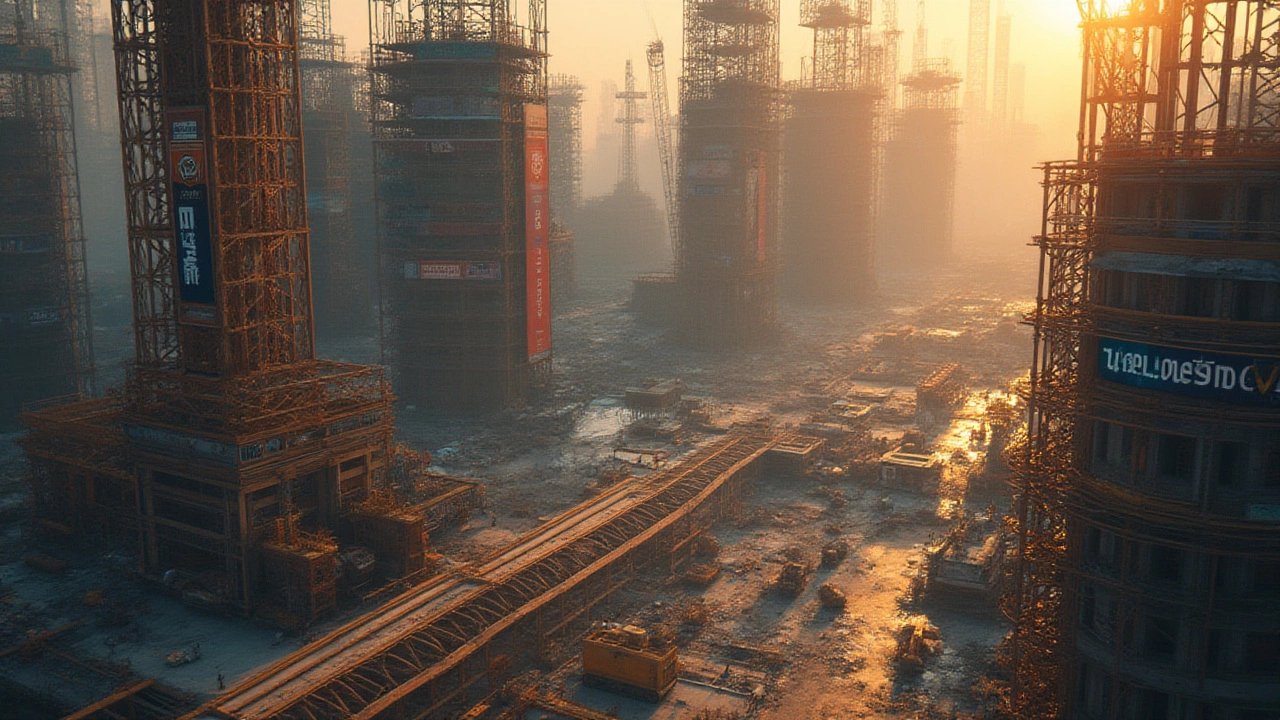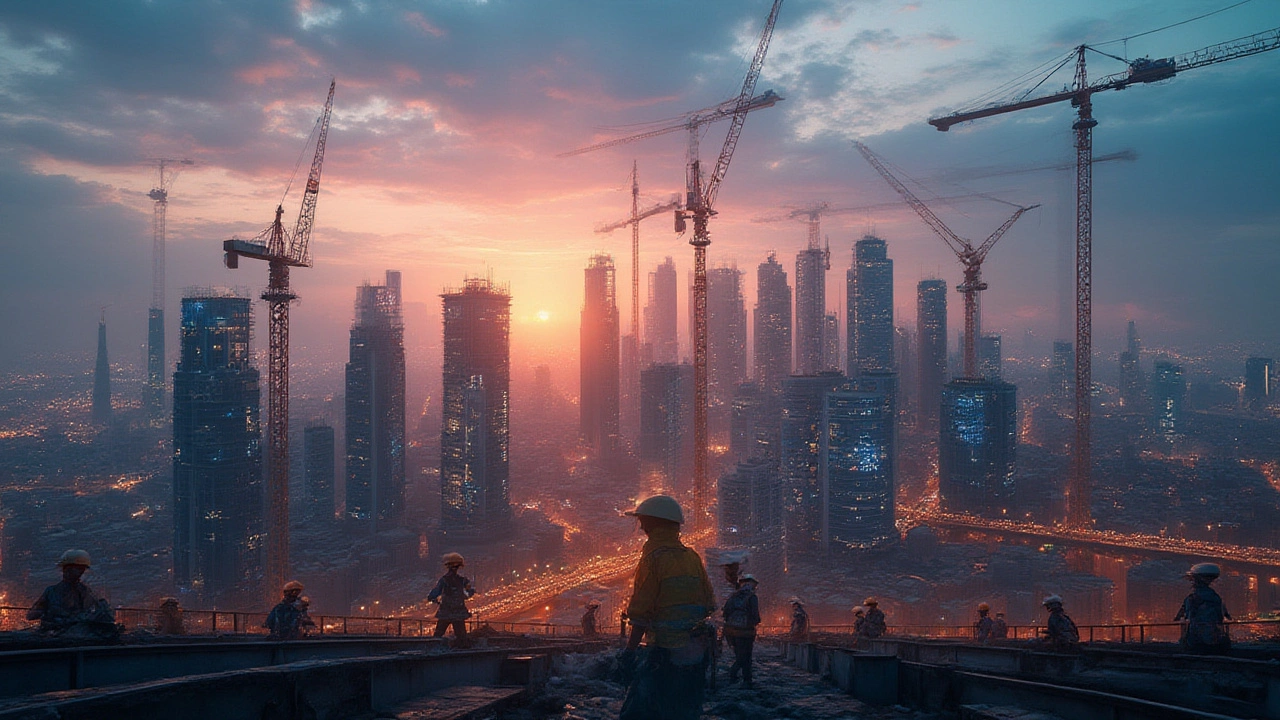Picture a world without construction giants—the bridges just don’t connect, skyscrapers look stunted, and highways stop somewhere in the middle of nowhere. The biggest construction companies quietly shape the spaces you live, work, and play in, from Dubai’s glittering skyline to LA’s evolving highways and even the bullet trains in Tokyo. But the real surprise? Most people could barely name a single one, yet their daily lives depend on these powerhouses pulling off the impossible.
What Sets the World’s Top Construction Companies Apart?
Sure, size matters in construction. But it’s not just about muscle; it’s brains, speed, safety, and some wild ambition that define the leaders. The world’s largest construction companies don’t just pour concrete faster—they use nearly futuristic tech, own fleets of specialized machines, attract the best engineers, and win contracts where everyone else hesitates. It’s so much more than just building a tall building or a massive dam. These companies set global standards, launch eco-friendly megaprojects, and even bring tiny cities back from disaster. The drive to top the industry leaderboard is brutal—out of thousands, only a handful make it to the very top by staying relentlessly ahead.
Most of these companies have tangled histories: family firms that turned global, national titans boosted by state investment, and mergers that fused regional players into world-changers. Having a diverse project portfolio keeps them afloat through turbulent markets—think airports in Qatar, data centers in Norway, housing in Brazil. Inside sources say that the margins can be surprisingly thin for such massive deals, with razor-sharp project management as the only safety net. Sustainability is also no longer a nice-to-have; it’s a ticket to the game, with recent global surveys showing that over 80% of construction investors now look for a strong environmental track record before jumping in.
And then there’s the sheer scale: Everything about these companies is super-sized. Teams count in the hundreds of thousands. Annual revenues can soar above $50 billion. Safety protocols are tested by robots and AI in real time. Some, like ACS Group or Vinci, have even branched outside traditional construction into real estate development, energy infrastructure, and smart tech, making them true juggernauts. So, how did these global legends get here, and who made the list this year?
The Top 10 Construction Companies In the World
There’s always heated debate about the rankings, but these ten names keep showing up and hold the world stage. They win the biggest contracts, complete mega projects ahead of schedule, and their annual turnovers could keep small countries running for a year. Here’s a quick hit list before we dig into their game-changing contributions:
- China State Construction Engineering Corporation (CSCEC, China)
- Vinci (France)
- ACS Group (Spain)
- China Railway Group (CREC, China)
- China Railway Construction Corporation (CRCC, China)
- Hochtief (Germany)
- Skanska (Sweden)
- Bouygues Construction (France)
- Bechtel (USA)
- Obayashi Corporation (Japan)
Let’s flesh out some context. Three of the world’s top five construction companies come from China, reflecting just how massive infrastructure development has been there in the past twenty years. CSCEC isn’t just the world’s biggest—with revenues topping $250 billion and nearly 400,000 employees, it has built everything from the iconic Beijing National Stadium (“Bird’s Nest”) to entire railway systems. Vinci, based in France, has a 120-year history and controls gigantic highway networks across Europe. Spain’s ACS Group is a master of global mergers and urban mega-projects, snatching up key players like Hochtief and Turner Construction along the way.
These aren’t just paper giants. Bechtel in the US is a household name if you’ve ever read about the Channel Tunnel or learned how the Hoover Dam was built. Sweden’s Skanska takes pride in eco-design, landing the first LEED-certified building in the Nordics. Obayashi famously helped Tokyo recover after disaster, rebuilding roads in less than a week after earthquake damage, making headlines for speed and innovation. What all these companies share is razor-focus on project delivery—and portfolios that literally hold up parts of the world.
For a snapshot that compares just how mammoth their operations are, here’s a quick table of recent numbers (2024):
| Company | Country | Revenue (USD billions) | Employees | Notable Projects |
|---|---|---|---|---|
| CSCEC | China | 256 | 380,000+ | Beijing National Stadium, Shanghai Tower |
| Vinci | France | 68 | 220,000+ | Stade de France, London’s King’s Cross |
| ACS Group | Spain | 44 | 120,000+ | Hoover Dam Bypass, Sagrada Familia |
| CREC | China | 163 | 289,000+ | Jakarta-Bandung High-Speed Rail |
| CRCC | China | 136 | 330,000+ | Doha Metro, Algiers Airport |
| Hochtief | Germany | 27 | 33,000+ | Elbphilharmonie Hamburg, Sydney Metro |
| Skanska | Sweden | 18 | 30,000+ | World Trade Center Hub (US), Elizabeth Line (UK) |
| Bouygues | France | 19 | 79,000+ | Channel Tunnel, Musée d'Orsay |
| Bechtel | USA | 17 | 55,000+ | Channel Tunnel, Sydney Metro |
| Obayashi | Japan | 18 | 15,000+ | Tokyo Skytree, Oakland Bay Bridge |
What this means is the big players aren’t just stacked with resources—they’re trusted to handle complexity that would crush smaller firms.
Iconic Projects: Engineering Wonders That Push the Limits
Stories about these companies read like action movies. Take the Shanghai Tower, built by CSCEC, twisting into the skyline at over 2,000 feet tall, or the Channel Tunnel—a feat of digging and logistics linking England and France—completed by joint ventures with Bouygues and Bechtel. Vinci has a near-monopoly on highway concessions in France, engineering smart roads that automatically count traffic and adjust tolls in real time. Hochtief’s partnership for the Sydney Metro introduced platform screen doors and 21st-century safety features most cities only dream about.
But the most mind-bending stuff is often invisible. Massive underground data centers cooled by Norwegian fjords, super-secret control rooms for nuclear power plants, high-speed rail that crosses deserts and earthquake zones—you name it, they’ve done it. Many of these mega-projects have multi-billion-dollar budgets and deadlines that can push entire economies. For instance, the Jakarta-Bandung High-Speed Rail project, carried out by CREC, cut a 3-hour trip down to 40 minutes and set a high bar for developing countries eyeing infrastructure upgrades.
It’s not all rosy, though. These giants walk a tightrope when it comes to risk. Delays, labor shortages, sudden regulation changes—it doesn’t take much to turn a profitable contract into a giant headache. A single rebar shortage in 2022 nearly ground two European projects to a halt, but quick-shifting purchasing teams snapped up supplies from Asia to get things moving again. And in disaster responses, speed can be everything. Obayashi’s stories from Japan’s earthquake zones and Bouygues’ fast-rebuild after Paris floods highlight just how critical nimble leadership is at this scale.
If you spot a city skyline filled with cranes, you bet at least two of these ten are working behind the scenes. Some folks talk about “signature” architecture—these firms deliver city-shaping reality, often in record time.

Behind the Scenes: Innovation, Safety, and Sustainability
Now, here’s where things really get interesting. These companies don’t just rely on hard hats and blueprints—they pour millions into automation, digital modeling, drones, and AI. Vinci, for example, pulled off Europe’s first 3D-printed bridge sections. Skanska recently piloted augmented reality glasses so foremen could spot design errors before a beam ever arrived. Some, like ACS and Hochtief, use AI to monitor project timelines—if one tiny delay pops up, the whole timeline recalibrates instantly, reducing the classic construction chaos.
Safety is another monster topic. With thousands of boots on the ground, slip-ups used to be inevitable. Now, robotic spot-checkers roam sites, sensors scan workers’ vests, and digital “safety twins” predict trouble before it happens. China’s CSCEC set up an AI system in 2024 that cut safety incidents by 30% on its biggest sites, according to their internal audit data.
Sustainability has become a competitive edge. Skanska, Bechtel, and Bouygues pour real brainpower into eco-friendly builds. Vinci recently pledged to hit net zero by 2030—no small feat for a titan pouring gigatons of concrete. The big European players invest heavily in green materials, water recycling, and offsite modular construction. Even China’s giants have started massive solar buildouts and stadiums that self-cool with natural ventilation. Contractors are eyeing circular construction, where old building parts get a second life, instead of ending up in landfills. The biggest clients—think Olympic committees or entire governments—now demand these credentials before signing billion-dollar deals.
What Does It Take to Work With or For These Giants?
If you’re a supplier, engineer, or young recruit, working with the best in the business is both a badge of honor and a serious challenge. For smaller firms, just landing a spot in the supply chain for someone like Bechtel, Vinci, or CRCC can mean stability for years. But it’s not for the faint-hearted. Every minute detail—quality, on-time delivery, sustainable sourcing—gets scrutinized. Trenton, my oldest, actually asked about internships at Vinci, and let me tell you, they want sharp minds and serious dedication. Language skills, advanced degrees, time spent in challenging locations—they all help land you an interview.
These leading companies also fuel whole economies: training armies of tradespeople, supporting apartment booms, and upgrading cities with everything from EV charging stations to super-wired schools. They have huge corporate training budgets and sponsor scholarships for promising young talent. More than half have formal diversity targets, with Skanska and Bechtel publicly reporting their inclusion numbers since 2023.
Advice for vendors: brush up your digital compliance, sustainability reporting, and supply chain transparency. These giants expect suppliers to have their paperwork in order, with digital systems tracking everything from steel provenance to worker safety. Stay nimble—regulations can change mid-project, and these clients won’t wait for you to catch up.
Final Thoughts: Where Are the Next Big Players Coming From?
The top ten shake up the rankings every few years, but the *real disruptors* aren’t always who you expect. Up-and-comers from South Korea, India, and the UAE are pulling off headline-grabbing projects and snapping up global contracts. Look for names like Samsung C&T or Larsen & Toubro to threaten the regulars very soon. The world’s infrastructure needs are huge, and as sustainability and automation race ahead, agility and brains—plus plenty of guts—will keep the current giants on top, at least for now.
Keep your eyes on the skyline near you—chances are, one of these companies helped shape it. And the next time a city’s future seems impossible, remember, these crew are somewhere behind the scenes, building the dream.

Written by Fletcher Abernathy
View all posts by: Fletcher Abernathy